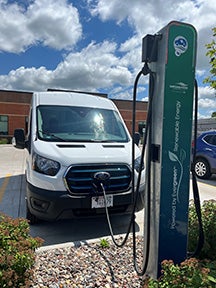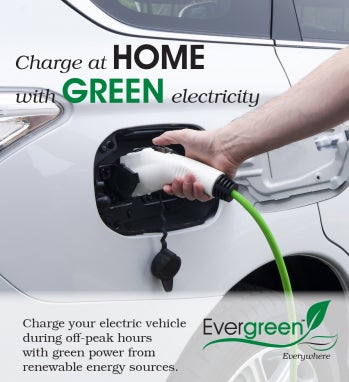Electric Vehicles
An electric vehicle is an automobile which utilizes electricity that has charged a large battery to run the vehicle. The two most common types of electric vehicles include:
BEV: Battery electric vehicles utilize a battery to power the vehicle's motor. The battery is charged mostly through plugging into a charging station either at home, work or in a public area; regenerative braking also provides a minimal charge as the vehicle transfers energy from the vehicle's forward movement to the battery as the vehicle slows down. According to the Electric Power Research Institute (EPRI), 80 percent of EV charging takes place at the owner's home, 15 percent at work and 5 percent at a public charging station. Public charging stations can be most easily found via smartphone apps.
PHEV: Plug-in hybrid vehicles have a smaller battery that supplements a traditional internal combustion engine to power the vehicle. Most PHEVs can drive between 20 to 40 miles on a single charge, which means most vehicle owners can utilize the battery power for their daily commute and local errands. Once the battery is drained of power, the engine takes over until the battery can be charged again.
There are also hybrid vehicles on the market, which cannot be plugged in, but utilize a battery-powered by regenerative braking and coasting to support the internal combustion engine, which improves the vehicle's overall miles per gallon (mpg) rating.

A Charger for Every Co-op
In 2018, Dairyland Power Cooperative offered each of its 24 local member distribution cooperatives a Level 2 electric vehicle charger as part of its overall incentive program.
Initiatives to install more chargers along major highways are helping alleviate “range anxiety” (fear of being stranded with a dead battery because the distance to your destination is beyond the range of your battery’s charge). The greater distances between destinations in rural areas is a common reason why many electric cooperative members hesitate to own an EV. Local electric cooperatives are a driving force to ensure new technology is not limited to more densely populated metropolitan areas. The availability of chargers at each local electric cooperative creates awareness about EVs and expose members to the possibilities of the technology.
Level 2 chargers add about 20 miles of range for every hour of charge. While that's not fast, the program will promote EV travel between member cooperatives and enhance awareness for their consumer-members.
Consumers may qualify for a federal tax credit up to $7,500 when they purchase an EV. Contact your local electric cooperative to see if they offer additional incentives for members who own EVs. Incentives might include a discount on a Level 2 charger for the member's home or a reduced (off-peak) electricity rate for enrollment in a load management program. Load management allows the cooperative to shift vehicle charging to the times when electricity is less expensive (usually evening and overnight).
Consumer-members interested in furthering their commitment to “go green,” can also request to be enrolled in the electric cooperatives’ green power program. Evergreen Everywhere participants can offset their vehicle charging use with four 100 kWh blocks of renewable energy each month.
electric cooperatives’ green power program. Evergreen Everywhere participants can offset their vehicle charging use with four 100 kWh blocks of renewable energy each month.
| Touchstone Energy Fact Sheets |
|---|
| Nuts & Bolts of an Electric Vehicle |
| Nuts & Bolts of a Plug-in Hybrid Vehicle |
| EV Overview |
